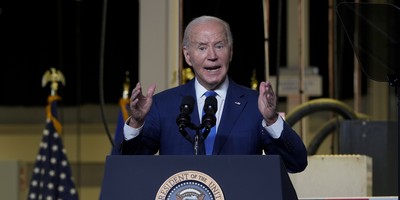Will Barack Obama become the first president in the post-World War II era during whose term real gross domestic product never grew in any quarter at an annual rate greater than 4 percent?
With less than optimistic recent forecasts from the Federal Reserve System's Federal Open Market Committee and the Congressional Budget Office, it now seems like a very real possibility.
Having been inaugurated in January 2009, Obama has served as president in 10 quarters. Without doubt, he came into office in a severe recession. In three of the quarters of 2008, according to the U.S. Bureau of Economic Analysis, real GDP grew at a negative annualized rate, dropping as low as -8.9 percent in the fourth quarter of that year.
At the beginning of Obama's term, real GDP remained negative in the first two quarters, hitting -6.7 percent in the first quarter of 2009 and -0.7 percent in the second quarter.
But two full years have passed since then. During that time, real GDP peaked in the first quarter of 2010, hitting an annualized rate of 3.9 percent.
Since that modest peak a year and a half ago, the economy has been on a generally downward trend, with growth of real GDP hitting a dismal 0.4 percent in the first quarter of this year and a nearly as dismal 1 percent in the second quarter.
Now both the FOMC and the CBO are indicating they do not expect vigorous economic growth to resume any time soon.
"The Committee now expects a somewhat slower pace of recovery over coming quarters than it did at the time of the previous meeting and anticipates that the unemployment rate will decline only gradually toward levels that the Committee judges to be consistent with its dual mandate," the Federal Reserve Board said Aug. 9 in a news release. "Moreover, downside risks to the economic outlook have increased."
Recommended
The CBO predicted last week that unemployment will remain above 8 percent until more than a year after the next presidential inauguration -- which will take place Jan. 20, 2013.
"With modest economic growth anticipated for the next few years, CBO expects employment to expand slowly," the CBO said. "The unemployment rate is projected to fall from 9.1 percent in the second quarter of 2011 to 8.9 percent in the fourth quarter of the year and to 8.5 percent in the fourth quarter of 2012 -- and then to remain above 8 percent until 2014."
Previous post-World War II presidents who have seen the economy contract while they were in office have also seen the economy come roaring back.
In 1949, when Harry Truman was president, real GDP dipped into negative territory for three of the four quarters, going as low as -5.5 percent in the first quarter of that year.
But by the first quarter of 1950, real GDP was growing at an annualized rate of 17.2 percent. In the second quarter of that year, it grew by 12.7 percent. In the third quarter, it increased by 16.6 percent.
When Dwight Eisenhower was president, real GDP declined from the second quarter of 1957 through the first quarter of 1958 -- when it hit an annualized rate of -10.4 percent.
But in the five quarters after that, real GDP grew at annualized rates of 2.5 percent, 9.7 percent, 9.7 percent, 8.3 percent and 10.5 percent.
Real GDP was negative in four of Ronald Reagan's first seven quarters in the presidency -- hitting a low of -6.4 percent in the first quarter of 1982. But by the second quarter of 1983, the U.S. economy was humming again, with growth at 9.3 percent.
That 9.3 percent growth in real annualized GDP in the second quarter of 1983 was followed by successive quarters of 8.1 percent, 8.5 percent and 8 percent growth. In fact, the economy never stopped growing for the rest of Reagan's presidency.
Even George W. Bush, who saw real GDP decline by 1.3 percent and 1.1 percent in two out of his first three quarters in office -- including in the quarter that included 9/11 -- saw real GDP bounce back to 6.3 percent by the third quarter of 2003.
For Obama to match that, the economy would need to be growing at 6.3 percent right now.
So, why isn't it?
Perhaps it is simply because people who in other periods would be investing their money, taking risks, building businesses, creating jobs and making themselves and their neighbors wealthier people are holding back out of the reasonable fear that under President Obama, there could be escalating government taxation and regulation, which would make their hard work and investment not worth the risk.

























Join the conversation as a VIP Member